23+ Best Body Horror Movies
Body horror is a subgenre all about revolting distortions of the human body, and the best body horror movies crank up the revulsion to extremes. Here are a few of the absolute best body horror movies ever.

Table of Contents
What is body horror?
Body horror movies are usually meant to elicit a feeling of revulsion in the viewer by playing on fears of physical vulnerability (which can tap into psychological horror). Sometimes bodies transform through natural or seemingly unnatural means, causing a character to feel uncomfortable in their own skin. Many body horror films also involve disease, parasites, infections, or some other invading force that plants itself within the body, mutating it from the inside. Movies like The Fly (1986) fit in to this category. Other times body horror is the result of an outside force, like a mad scientist modifying a person’s body in horrific ways. The Human Centipede (2009) is an example of this.

Some people argue that movies such as The Fly (1958) and even Frankenstein (1931) contain elements of body horror. However, the body horror genre predominantly exists from the 1970s onward when incredible advances in practical special effects allowed filmmakers to show human bodies distorted in ways only dreamed of in decades prior. David Cronenberg’s movies Shivers (1975) and Rabid (1977) began a wave of horror films that utilized these grotesque special effects as key components.
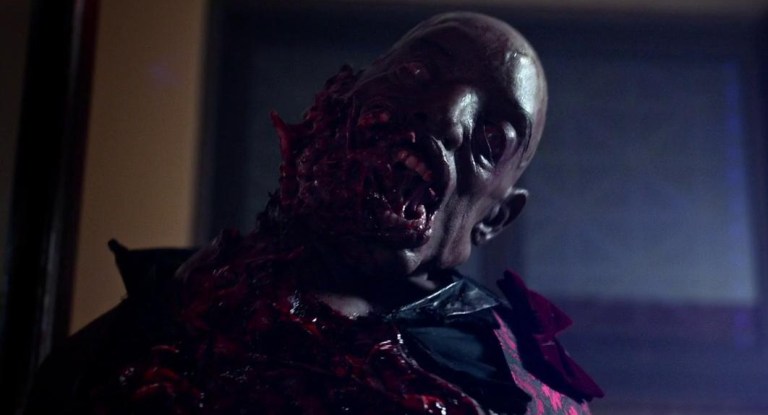
The body horror wave continued throughout the 1980s, and the term “body horror” was coined at that time to describe the newly formed subgenre. As digital effects became more prominent in the 1990s, body horror began to fade from the mainstream. The popularity of “torture porn” (which is generally not body horror) in the 2000s continued to relegate body horror to a niche category for another decade. Then, perhaps inspired by fears of disease and an increased societal dialogue about bodily autonomy, body horror began to reemerge in the 2010s. This list highlights the best movies from the golden age of body horror in the 1970s and 1980s, all the way up until today.
The Best Body Horror Movies Ever
Eraserhead (1977)

Alongside David Cronenberg, David Lynch is a pioneer of the body horror subgenre. And really, Lynch’s debut film Eraserhead took body horror to even more bizarre extremes than Cronenberg’s earliest movies. Eraserhead is a surreal tale of a man, Henry Spencer (Jack “John” Nance), who is thrust into fatherhood when his girlfriend Mary X (Charlotte Stewart) gives birth to a baby that looks more like a snake embryo than a human. The baby’s fragile body gets more disgusting as the movie goes on, and Spencer himself undergoes a strange transformation during what is likely a dream or vision. As dreamlike as the whole movie is though, it’s difficult to tell what’s real and what isn’t (which is the whole point anyway).
The Brood (1979)
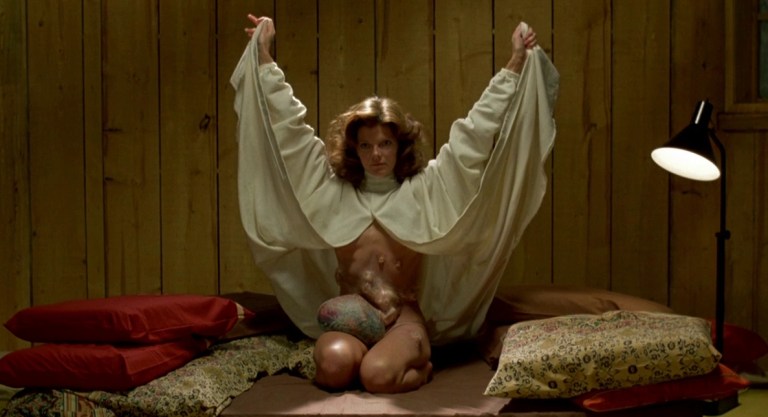
David Cronenberg was inspired to create The Brood after a particularly nasty divorce. Samantha Eggar stars as Nola Carveth, a scathing facsimile of Cronenberg’s ex-wife and a woman undergoing an extreme form of psychotherapy for her mental issues. Samantha’s estranged husband Frank (Art Hindle) and their daughter Candice (Cindy Hinds) fear for their lives when people around them are murdered by strange, distorted children. The finale of The Brood is quite a sight to behold as Nola gives birth to a child through an external womb created as a byproduct of her doctor’s (Oliver Reed) experimental “psychoplasmatic” therapy. It’s bizarre and more than a little disturbing.
The Thing (1982)
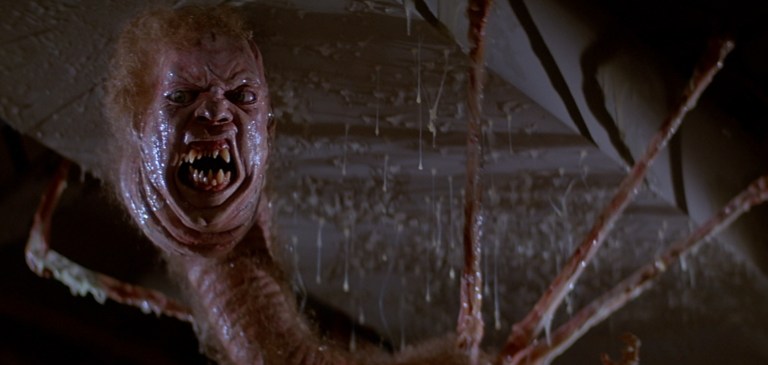
Starring Kurt Russell in one of his most iconic roles, The Thing is the best example of an alien invasion body horror film. Based on the novella Who Goes There by John W. Campbell Jr. and taking inspiration from The Thing From Another World (1951), The Thing is about an alien being that has the ability to mimic any other living creature. When threatened, the being transforms into bizarre monstrosities that often still retain a bit of its most recent form. Examples include a self-severed head that grows spider-like legs, a torso that opens up like a gigantic mouth, and other less coherent forms that likely resemble a human melted and reformed into any number of alien creatures the thing encountered before it landed on Earth.
Videodrome (1983)

James Woods and Debbie Harry star in Videodrome, David Cronenberg’s exploration of the impact of violent media. Woods plays Max Renn, the president of a TV station who becomes obsessed with a mysterious television broadcast, a show titled Videodrome, that depicts disturbing violence. As Max is drawn further into the hallucinatory effects of the show, his mind and flesh are altered. In one memorable scene of classic body horror, Max has a pulsating Videodrome video tape inserted into a slit in his abdomen, later pulling out a gun that melds with his hand in a goopy, fleshy mass. The symbolism is not subtle, but it is quite effective.
Re-Animator (1985)
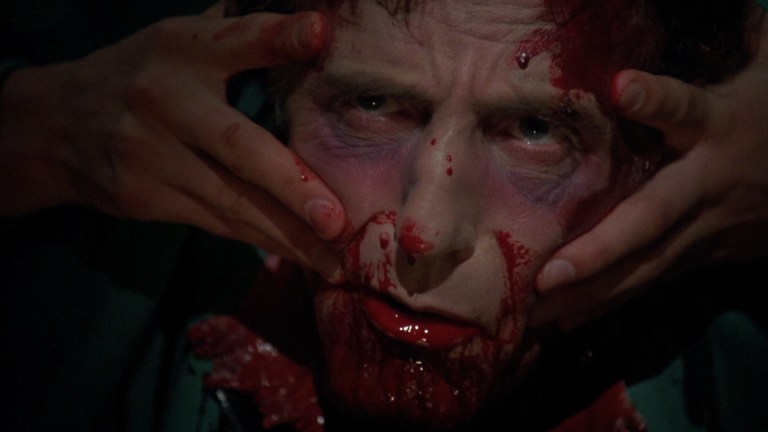
Stuart Gordon is another director who made a name for himself early in his career with body horror. Gordon’s first theatrically released movie as a director was Re-Animator, a mad scientist movie based roughly on H.P. Lovecraft’s story “Herbert West-Reanimator.” Jeffrey Combs is Herbert West, a medical student who invents a serum that brings the dead back to life. Unfortunately for West and the people around him, his serum often has horrific side effects like zombification and murderously violent tendencies. Though the body horror in Re-Animator isn’t really the movie’s main focus, it does begin with a man’s eyes exploding out of his face, and the main villain is a reanimated severed head who is occasionally carried around by his headless body.
From Beyond (1986)
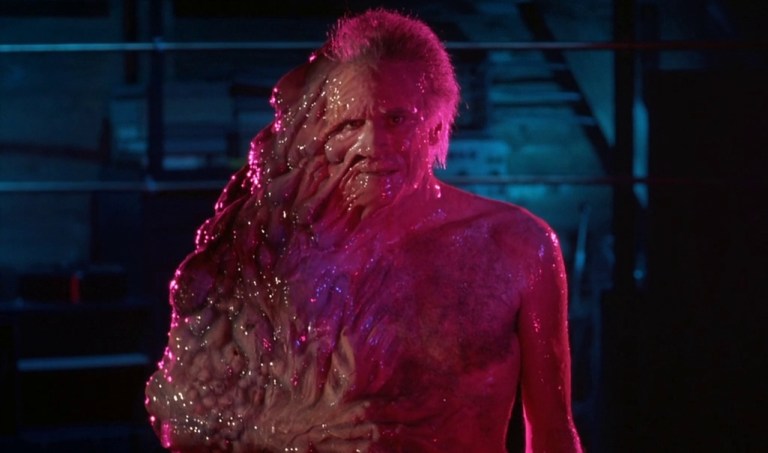
After enjoying his time making Re-Animator, director Stuart Gordon decided to make another movie with much of the same cast and crew, and based on another story by H.P. Lovecraft. From Beyond is inspired by the Lovecraft story of the same name, and it is about an experiment that gives humans access to a reality that overlaps our own. The head scientist on the project, Dr. Pretorius (Ted Sorel), is taken into the other reality and transformed into a power-hungry monster that continually morphs into hideous forms that increasingly distort his human appearance. There are also a bunch of monsters that come through into our reality, many of which have a affinity for eating people starting with their head.
The Fly (1986)
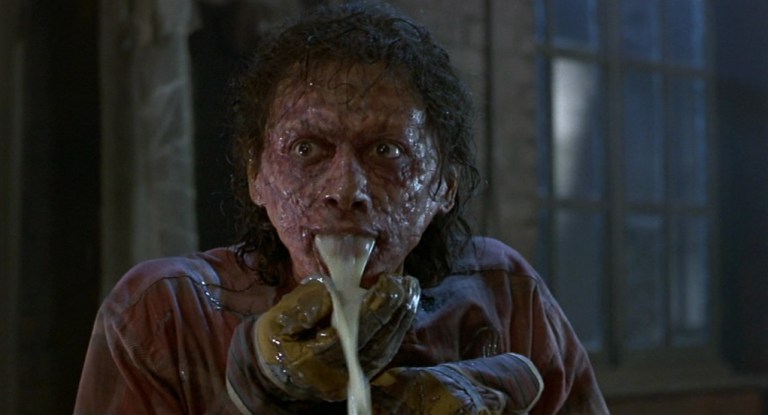
The Fly shares the same basic premise of the 1958 movie of the same name: a scientist teleports himself using his own experimental invention, not knowing that a fly was also in the teleportation chamber. The scientist, Seth Brundle (Jeff Goldblum), then transforms into a human/fly hybrid, though the transformation process in Cronenberg’s movie is vastly different from the earlier version of The Fly. Brundle’s body falls apart piece by piece as he grows more and more fly-like throughout the film. Though, yes, it’s really gross, Jeff Goldblum and his costar Geena Davis make the movie a joy to watch.
Street Trash (1987)
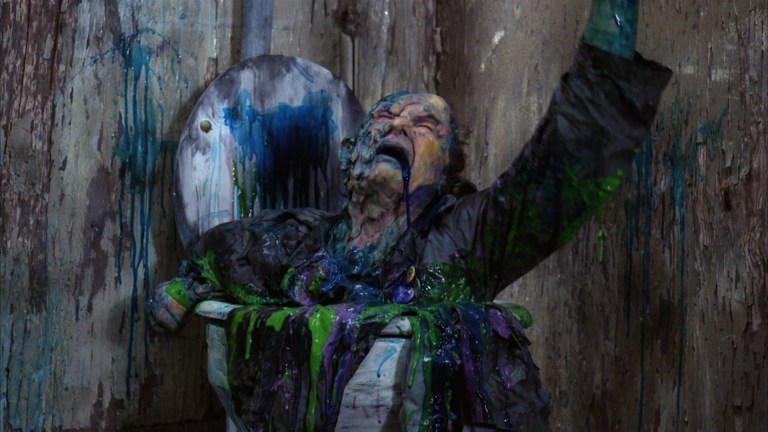
In a weird way, Street Trash might be the most beautiful body horror movie. Directed by J. Michael Muro, it is about an unscrupulous liquor store owner who finds mysterious bottles of decades-old alcohol and sells them to local homeless people. The alcohol is deadly, rapidly melting the people who drink it into pools of rainbow-colored sludge. There aren’t a ton of redeeming qualities in this unabashedly trashy horror comedy, and that’s why it’s so much fun.
Hellraiser (1987)

Hellraiser is a movie that smartly blends multiple subgenres of horror. The Cenobites led by Pinhead (Doug Bradley) come from another dimension, giving the movie an element of cosmic horror. Clare Higgins’ character Julia tricks random men into accompanying her into a room where she and her brother-in-law/lover Frank (Sean Chapman) can murder them, granting the movie a touch of the slasher tropes so prevalent in the 1980s. And Frank himself brings body horror to the movie, existing for most of the film as a collection of bones and fluid that reforms into a living human as he absorbs the life forces of dead men.
Guinea Pig: Mermaid in a Manhole (1988)

The notoriously extreme Guinea Pig movies from Japan are primarily known for their splatter and gore, but Mermaid in a Manhole is also a gruesome body horror movie. It tells the story of an artist who discovers a sick mermaid in a sewer and takes her back to his apartment. The artist paints a picture of the mermaid, and as her illness gets worse, he uses the multicolored puss from her countless boils to highlight his artwork. It only gets worse from there as the mermaid’s body continues to deteriorate and worms burst out of the increasing number of oozing pustules. Mermaid in a Manhole is certainly one of the more stomach-turning movies ever made.
Akira (1988)
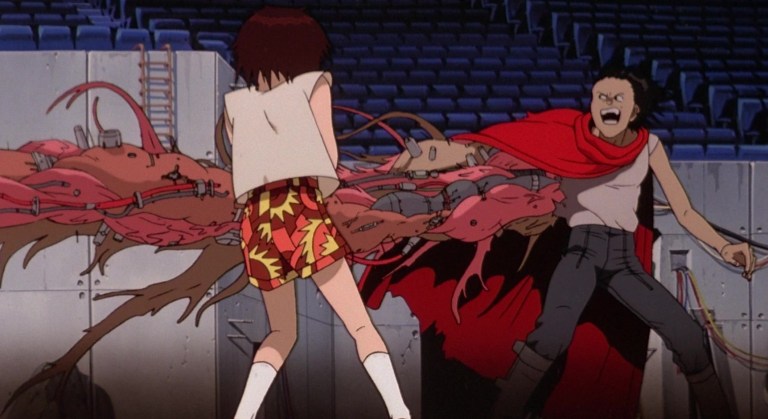
This list is primarily geared more towards live action rather than animation, but it would feel weird to exclude one of the greatest body horror movies of all time: Akira. Set in a dystopian future after the third world war, Akira follows a motorcycle gang when one of their members, Tetsuo, develops psychic abilities. Tetsuo’s friend Kaneda tries to save Tetsuo as his powers grow dangerously out of control, threatening to destroy Neo-Tokyo. Though the movie is rightly categorized as cyberpunk, the body horror mostly comes in late in the movie when Tetsuo’s body mutates to horrifying proportions. Akira is one of the most influential movies ever, animated or otherwise.
Society (1989)
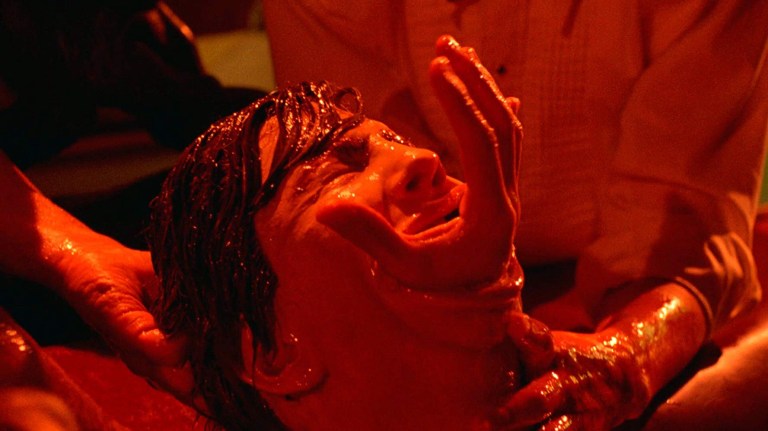
In its finale, Society displays one of the most absurd and memorable scenes in all of body horror. Building up to that finale is a darkly humorous satire of social elites. Bill Whitney (Billy Warlock) feels out of place within his own high-society family. After hearing a recording that seems to expose his parents’ as secret deviants, Bill’s investigation leads him to some disturbingly gruesome discoveries. Without spoiling exactly what is going on, the final minutes of Society contain an almost indescribable orgy of horrific and goofy body transformations. For many people, the image of a man’s laughing face protruding from a butt is an image that cannot be forgotten.
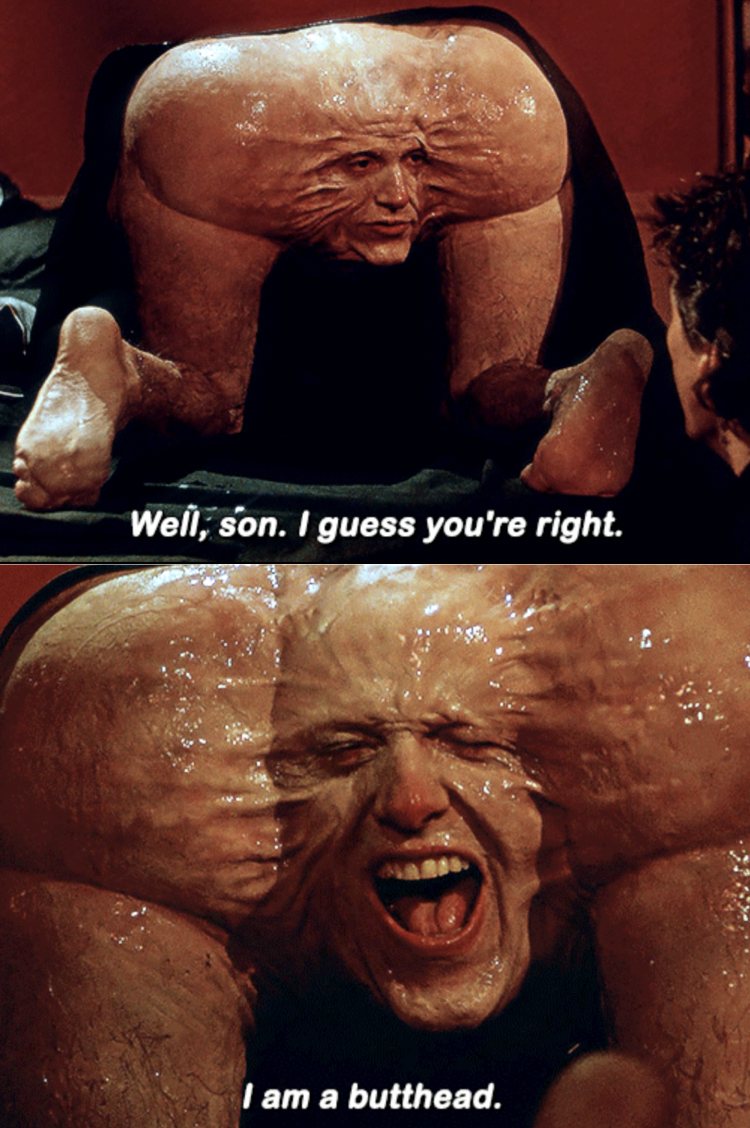
Testsuo: The Iron Man (1989)
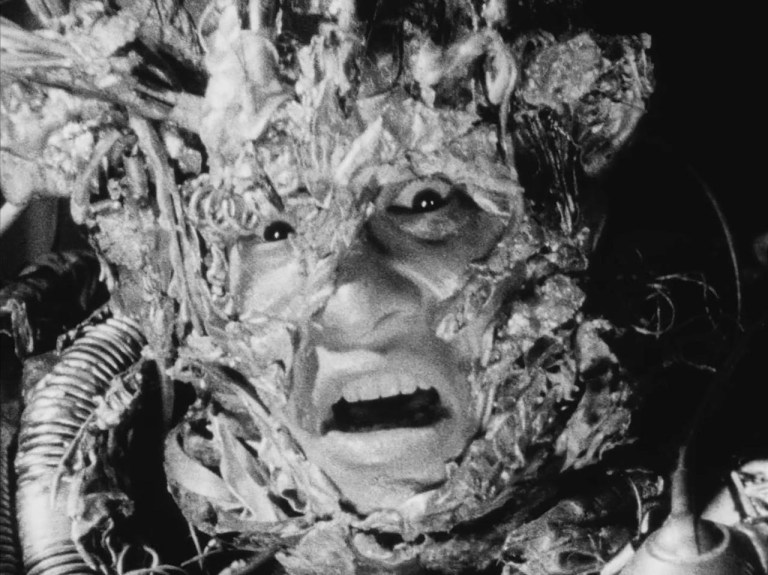
In 1989, iconic Japanese filmmaker Shinya Tsukamoto unleashed his revolutionary cyberpunk body horror movie Tetsuo: The Iron Man onto the world. It took a little while for people to catch up to Tsukamoto’s brilliance, but his movie eventually became one of the most important films in Japanese cinema. The movie is a surreal story about an ordinary man whose body gradually transforms into a mass of metal and flesh. However, the plot is somewhat incidental to the overall experience. Tetsuo is a glorious assault on the senses that feels more like a nightmare than a movie.
Cabin Fever (2002)
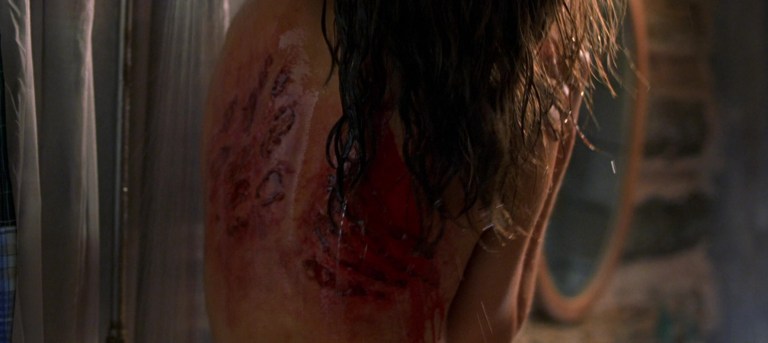
Black comedy and disintegrating flesh come together in Cabin Fever, the movie that established Eli Roth as a trash-horror auteur (that’s a compliment, not a slam). This is a cabin-in-the-woods movie featuring a group of young people who unfortunately decide to spend their spring break in a cabin where a flesh-eating virus is spreading. Cabin Fever never takes itself seriously, and some of the goofy humor may get too weird for some tastes, but the gore is good. The scene of an infected woman attempting to shave her legs as her skin comes off on the razor is a definite highlight of early 2000s horror.
Meatball Machine (2005)
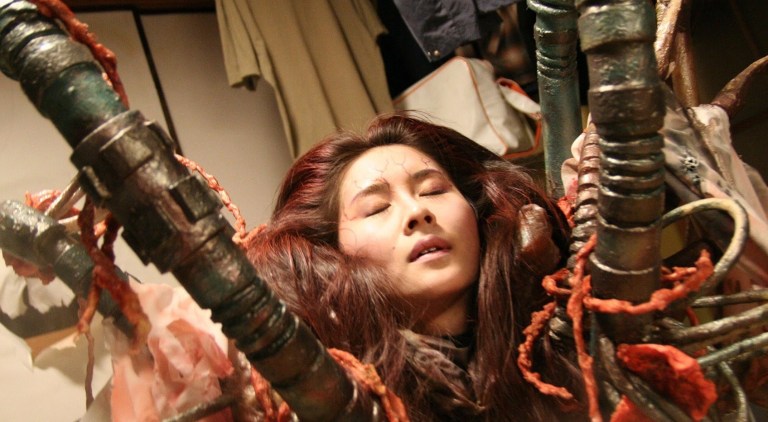
For fans of outrageous Japanese movies, Meatball Machine was a turning point. It was one of the first movies of a new wave of genre movies that combined splatter and body horror to ridiculous extremes. In Meatball Machine, a meek factory worker discovers an alien parasite that infects the girl he has a crush on. The parasite takes over the young woman’s body, turning her into a flesh-and-metal monstrosity known as a NecroBorg. There are more NecroBorgs in the city, and they fight each each other in bloody battles using human bodies essentially as bio-mechanical tanks. It’s incredibly over-the-top and super fun.
Slither (2006)

With allusions to sci-fi horror from the 1970s and 1980s and some of the most fun practical effects of its time, James Gunn’s Slither is one of the more underrated movies of the 2000s. Nathan Fillion is Bill Pardy, a small-town police chief who has to deal with an alien invasion. The aliens arrive on a meteorite and infect local resident Grant Grant (Michael Rooker), reshaping his body into a tentacled mound of flesh that serves as the patriarch of a brood of parasites that infect and zombify most of the townsfolk. One of the most gruesome examples of body horror in Slither is when a woman is impregnated by Grant, causing her body to balloon into a gigantic ball of flesh filled with squirming slug-like parasites. It’s great.
The Human Centipede II: Full Sequence (2011)
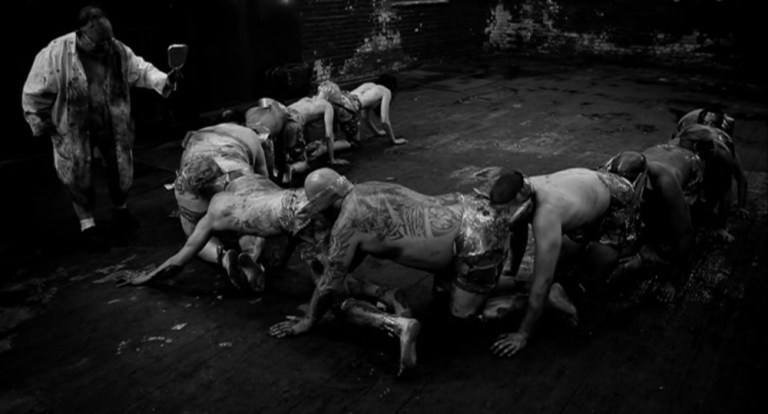
The Human Centipede movies are notoriously grotesque. The middle movie in the trilogy, 2011’s The Human Centipede II: Full Sequence, is the best at what the franchise intends to accomplish: deliver intentionally transgressive content meant to shock. Presented in black and white, the movie is about a mentally disturbed man who watches the first Human Centipede movie and decides he wants to create a centipede of his own. He kidnaps and tortures people before trying, failing, and trying again to attach them butt to mouth. Blood and other body fluids flow freely in this unabashedly trashy movie that is, by far, more mean-spirited than its predecessor.
American Mary (2012)
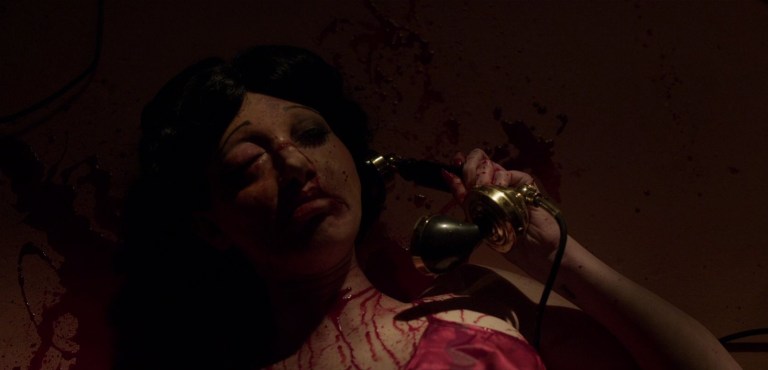
American Mary may be on the lighter side of body horror when compared to the rest of this list, but it is a cult favorite that warrants inclusion. Katharine Isabelle is Mary, a medical student desperate for money. She gets wrangled into performing an illegal surgery for a criminal, but the pay is really good. This opens Mary up to the idea of working outside the law, so when she is asked to perform extreme cosmetic surgery for a large sum of money, she agrees and starts her own dark-web surgery business. The most memorable example of body horror in American Mary may be her first extreme surgery which has her turn a woman into a living doll by permanently removing or masking all of her private areas.
Parasyte: Parts 1 & 2 (2014, 2015)
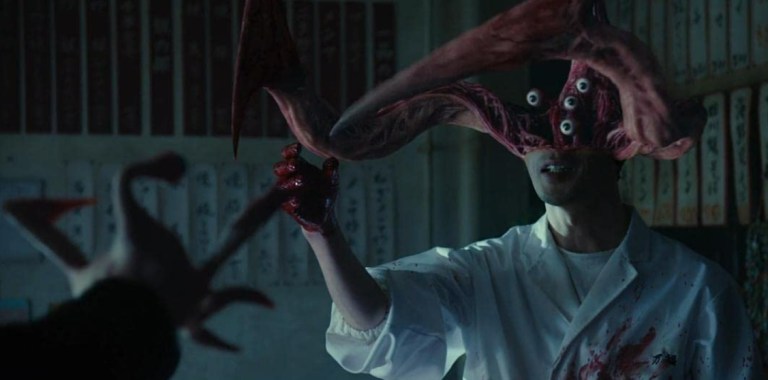
Parasyte was originally published as a manga (Japanese comic) beginning in 1988, but it took over 25 years for technology to advance far enough to bring the story to live action. The movie, told in two parts, is about alien parasites that enter people’s brain and take control of their mind and body. The parasite can then reshape their host body into just about any messed-up form imaginable. They also eat humans. A parasite attempts to take over a high school student named Shinichi Izumi (Shota Sometani), but it fails, only taking over Shinichi’s right hand. Now Shinichi and Migi (the alien) must coexist to survive since the other aliens can sense their bond, and they want to destroy them both.
Tusk (2014)
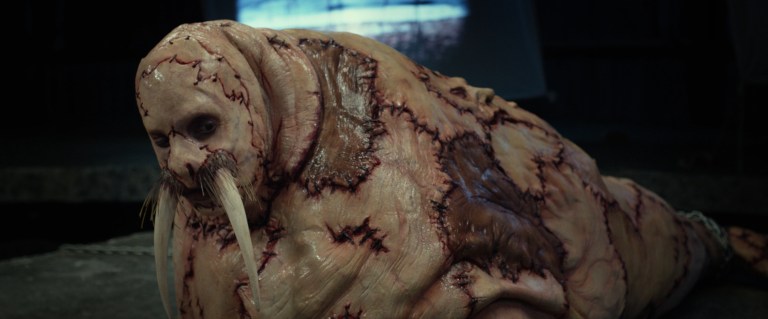
As a Kevin Smith movie, it’s no surprise that Tusk can get quite silly. But silliness and body horror can often be a foundation for some surprisingly unnerving moments. Such is Tusk, a movie about a reclusive old man named Howard Howe (Michael Parks) whose greatest desire is to medically transform a man into a walrus using human skin and bones. Abrasive podcaster Wallace Bryton walks into Howe’s trap, and after an intense conversation, Howe begins the transformation process. The stars of Tusk are phenomenal, especially given the premise, and they create some real horror. Take, for example, the moment when Wallace realizes that Howard has cut off his legs with the intention of shaping the bones into tusks which will be permanently attached to his face.
Malignant (2021)

Malignant was heralded as James Wan’s return to horror after he’d joined the DCEU (DC Extended Universe) by directing Aquaman (2018), and what a return it was. Annabelle Wallis stars as Madison, a woman in an abusive relationship. After being attacked by her husband, Madison finds herself supernaturally linked to a series of murders. Malignant is largely about the mystery of the murders, but body horror comes into play in a big way when the killer is finally revealed (though to say exactly how would be a huge spoiler). So, even though Malignant may not be a body horror movie through and through, it contains some of the best and most memorable body horror moments of the 2020s so far.
Crimes of the Future (2022)
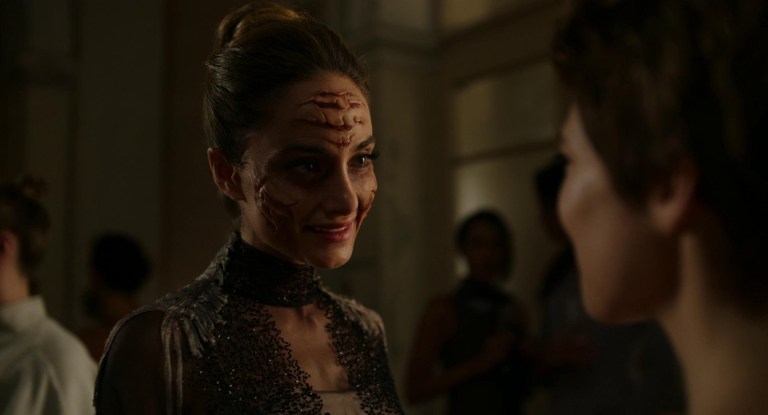
David Cronenberg returned to his body horror roots with Crimes of the Future. Set in the future, the movie is centered on a performance artist duo, Saul Tenser (Viggo Mortensen) and Caprice (Léa Seydoux). During this time humans have begun to spontaneously grow extra organs in their body, and Tenser becomes famous in the art world for allowing Caprice to tattoo and remove his extraneous organs in live surgery shows. The full story is complex and difficult to succinctly summarize, but to summarize the body horror, it comes from both natural and unnatural sources. In addition to newly formed organs being cut out and shown to the public, many people also willingly have bizarre modifications made to their bodies (such as a man covered in ears).
More Great Body Horror Movies

- The Incredible Melting Man (1977) – An astronaut goes murderously insane as his body slowly melts after passing through radiation in space. This is low-budget, goofy fun.
- Invasion of the Body Snatchers (1978) – Though this adaptation of Jack Finney’s 1955 novel The Body Snatchers is primarily a straight sci-fi horror film, there are moments of body horror including a wild-looking dog with a human face.
- Alien (1979) – This one may be a stretch to call body horror, but the idea of an alien growing inside your body and bursting out of your chest is quite horrific.
- Basket Case (1982) – Spoilers: This is low-budget camp about a pair of separated conjoined twins, one who looks like a regular man, and the other a hideous, screaming pile of flesh that lives in a basket and murders people while in a constant state of rage.
- The Stuff (1985) – There is an all-time great scene where Garrett Morris’ character mutates/melts while vomiting up the titular Stuff, an unknown substance found on the ground and sold in stores as a dessert.
- Brain Damage (1988) – This cult horror comedy depicts an intelligent parasite that injects a man with a euphoric chemical in exchange for the man taking him around on a killing spree. It’s silly, and there are at least a couple of truly great body horror images, especially during the finale.
- The Blob (1988) – A remake of the 1958 classic, this updated Blob has a ton of beautifully grotesque special effects showing a pleasantly pinkish alien blob melting people.
- Body Melt (1993) – This Australian indie horror comedy isn’t all that good, but it does deliver very well on the promise in its title: bodies do melt. Or rather, they ooze.
- eXistenZ (1999) – David Cronenberg, once again using body horror, this time telling a story about a future where virtual reality is experienced through fleshy ports inserted directly into people’s spine.
- Teeth (2007) – Based on the idea of “vagina dentata” (a vagina with teeth), Teeth is a movie that turns the human body into a horror (depending on your perspective).
- Contracted (2013) – A woman’s body deteriorates after she contracts what she believes is an STD, but it turns out to be something else entirely.
- The Autopsy of Jane Doe (2016) – Though not body horror in the traditional sense, this film turns the dead body of a jane doe into a source of horror and mystery.
- Suspiria (2018) – Luca Guadagnino’s remake of Dario Argento’s masterpiece has a few scenes of gnarly body horror, specifically a dancer whose body crumples in on itself, and a tableau of horrors in the finale.
- Cyst (2020) – A mad scientist (George Hardy, the father in Troll 2) creates a machine to remove cysts, but he also accidentally creates a gigantic cyst-monster.
- Titane (2021) – The body horror in Julia Ducournau’s Titane is largely overstated, but the bizarre pregnancy endured by the lead character Alexia (Agathe Rousselle) does lead to a few inexplicable body horror moments.
- V/H/S/94 (2021) – The segment titled “The Subject” (directed by Timo Tjahjanto) is about a mad scientist who changes humans into bio-mechanical killing machines made of flesh and steel.
